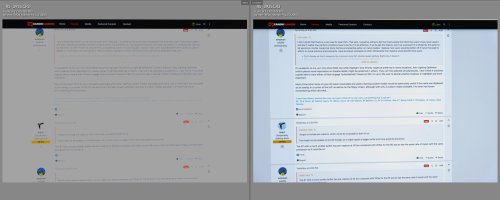I appreciate your thoughts, entoman. I shoot RAW exclusively too. What many users don't realize is that while Auto Lighting Optimizer doesn't affect RAW files, Highlight Tone Priority
does. It is easy to demonstrate this to yourself. Take two RAW photos of your computer screen, one with Highlight Tone Priority off, the other with it on. Use the exact same exposure settings making sure to completely blow the images out. Import them into Lightroom. The two photos will appear identical—until you drag down the Exposure slider. You will find significantly more recovery latitude in the file shot with HTP engaged. I've done exactly this in the screenshot below. (
Note: Recover using the Exposure slider, not the Highlights or Whites sliders.)
How does the feature work? The actual sensitivity of your sensor is fixed at its native ISO. When you increase the ISO setting, the camera takes the data coming off the sensor, amplifies it, and writes the resulting data to the RAW or JPG file. With Highlight Tone Priority engaged, the camera essentially tone maps the data, amplifying the darker tones but not the lighter tones when it records the image file. This is why the feature doesn't work at ISO 100 where there is no amplification happening. Some people argue that this is no different than shooting at ISO 100 and boosting the shadows. The principle is similar. The difference is your shutter speed. If you're shooting at ISO 800, it is typically because your shutter speed at ISO 100 is too slow.
Is there a downside to always using HTP? Not that I'm aware of, aside from being locked out of lower ISOs. The manual indicates that you may notice noise in the shadows. I've always assumed that this is the same high ISO shadow noise you'd notice with the feature turned off (shooting at the same ISO) but it's never been a problem so I've never bothered to do a comparison.
So do I always shoot with HTP engaged? Sadly, no. I typically shoot in Manual mode with Auto ISO engaged. If I'm shooting landscapes, for example, I have the time to turn the HTP feature on and off based on my ISO. But if I'm shooting street, things are happening quickly. I don't have the time to monitor ISO and change this setting. Hence, my feature request...
The screenshot below demonstrates what I have been describing. Both CR3s were shot with the exact same settings. They looked identical before I applied a -3.75 adjustment to the Exposure slider to both images. The image on the left shows the typical dull whites you get when there is no data to recover. The image on the right, shot with Highlight Tone Priority engaged, shows how much more data is available to recover. No other adjustments were made to either image.
View attachment 207889

